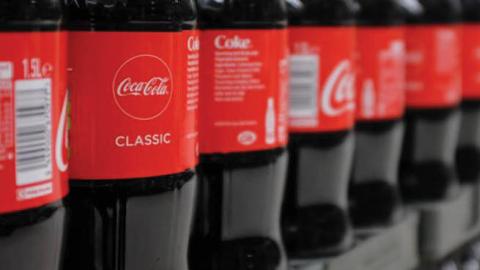The fizz is returning to Coca-Cola, after years of delivering flat returns on Wall Street and being regularly vilified by public health activists. James Quincey, CEO since 2017, recently said organic revenue grew 5% last quarter compared to last year and that Coke is now a “total beverage company” offering far more than the traditional carbonated sodas that made its products and brand ubiquitous globally.
That’s great news, for shareholders and health-conscious customers alike. But now Quincey and his leadership team must do a lot more to keep the turnaround going. After doing a commendable job putting healthier products in its portfolio, they need to focus on how the company markets its products and the environmental impact of their packaging. [Full disclosure: I previously served as a brand director for Coca-Cola USA in the 1980s and had consulted for them over five years ago.]
Coke’s nascent resurgence is heartening because it comes after years of self-inflicted struggles.
Most of them happened because the company refused to recognize its products’ impact on health and consumers’ growing preference for non-sugary refreshment. For example, the Center for Science in the Public Interest first published a report in 1998 titled “Liquid Candy” that blamed the soft drink industry for the obesity crisis. In response, the Center for Consumer Freedom, in part funded by Coca-Cola, publicly debunked the study’s findings and laid blame on the lack of exercise and physical education. Over a decade later, Coke again fashioned an initiative, the Global Energy Balance Network, uncovered by The New York Times in 2015, that attempted to use scientists to deflect attention from sodas to lack of exercise. Overall, the company has spent well over $100 million fighting soda taxes, which nonetheless have been adopted by several cities in the U.S. and around the world. Meanwhile, soft drink consumption has plunged in the U.S. by over 25% from its 1998 peak of 54 gallons per capita to under 40 gallons per person today.
All of this took the fizz out of Coke’s financials, after years of being a Wall Street darling. The company’s annual net operating revenues declined $16 billion between 2012 and 2018. From the peak consumption year (1998), it took 16 years (until 2014) for Coke to get back to the same share price. Since then, Coke stock has risen 24%, but it’s growing at less than half the S&P 500 growth (+54%).
Quincey seems to be turning the ship around. As a “total beverage company,” he has put less emphasis on Coke, Diet Coke and Sprite and more on better-for-you beverages and smaller portion sizes to appeal to a broader array of consumers. Its third-quarter growth was led by Coke Zero Sugar (up 14% globally in volume this year) and 7.5-ounce mini cans (with unit sales up 15% in the U.S. this year). Coke has also introduced sugarless versions of its energy and coffee drinks.
And along with PepsiCo and Dr Pepper Snapple, Coke committed to reducing calories consumed per person by 20% by 2025. While an applaudable move, it came a decade and a half after public health activists began singling out soft drink companies’ role in contributing to obesity.
Real change will require that Coke work much faster than that and do much more. To be a true industry leader, the company must step up and own the problems the industry has helped create. More importantly, it must fully commit that it is in it for the long game to help fix those problems.
This is a challenge that is being taken up wholeheartedly by other behemoths in other sectors – companies like Unilever, which is cleaning out brands that don’t stand for a higher purpose, and CVS Health, which dropped its drugstores’ $2 billion-a-year tobacco products. These companies recognize they are role models for their peers, competitors and the business world. They realize that being paragons and doing what’s right are good for business, especially in an age when this matters more than ever.
For Coke, taking such a leadership stance would go a long way to regaining the trust and loyalty of the desirable 18-to-34-year-old demographic (today’s Millennials and Gen Z segments). These consumers care about social issues, and they purchase products from companies that address those concerns. Coca-Cola needs to get into full alignment with today’s buyers to be the corporate leader it is capable of being.
Coke must also recognize that because its products are everywhere, it has a tremendous opportunity to improve the health of consumers globally. It’s already made commendable progress in addressing the product issues of sugar and calories tied to obesity. Here’s what Coke’s leaders need to do next:
Transition its portfolio to products that promote health and longevity. New products are the lifeblood of growth. Coca-Cola has the opportunity to proliferate with new beverages that actually enhance health. For example, Coke introduced Coke plus fiber in Japan, which lowers fat absorption and is targeted to the over-40 population. We need more of this as obesity rates continue to climb around the world. Refreshment was the driver for 20th century soda success; this century requires a better-for-you element to appeal to changing consumer tastes and needs.
Bring the solution to plastics waste. Coke has advanced a global goal to help collect and recycle the equivalent of 100% of the packaging it sells by 2030 and has already produced sample bottles made from plastics recovered from the ocean. While admirable, these efforts will need to be accelerated as just this week, as reported in Forbes, Coca-Cola was named the world’s most polluting brand in a plastic waste audit for the second consecutive year. With about 73% of coveted Millennials and Generation Z consumers willing to spend more money on products if they are sustainable, Coca-Cola needs to pull out of this reputational hole. Recycling is good, but a more concerted effort behind biodegradable packaging and other strategies that lessen their environmental impact are imperative.
Commit to reversing income inequality. While Coke, of course, is not responsible for those who struggle financially, these consumers are nonetheless heavy users of sodas, and high consumption rates of soda have been shown to correlate with obesity and thus health problems. Coke could step up and do right by them by focusing its advertising to encourage them to choose Coke’s healthiest options, and therefore reduce their financial and personal burdens of future possible health problems. By shaping a public commitment to helping their customers who can’t afford or access good health care, Coke has the opportunity to make a real impact and demonstrate social commitment and true leadership.
These problems are vexing. But they are not out of reach for this $32 billion (revenue) company. From the “Pause that Refreshes,” to its Hilltop ad’s message of world harmony, to the “Real Thing,” Coca-Cola over the years has demonstrated an ingenuity that has turned it into an iconic brand and an admired company.
The seeds of continued greatness are still there, but Coke’s leadership must nurture them — for the sake of the company and the consumers who can make or break its future.
Read in Forbes















